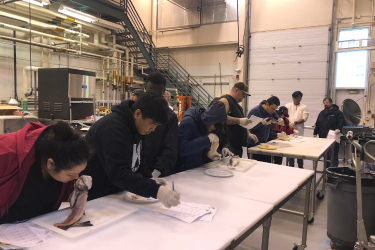In the wild, corals are threatened by changing ocean conditions and stressors associated with coastal population growth, such as nutrient pollution and sedimentation. Scientists know that certain changes, such as warming ocean temperatures, threaten corals more than others. Trying to determine how and why some corals can survive these stressors is more challenging.
Scientists at NOAA’s Southeast Fisheries Science Center partnered with the University of Miami to build a coral cultivation and research facility. The facility will help improve our ability to restore corals on Florida reefs. Being able to control variables like temperature, light, and salinity will enable scientists to get a better understanding what factors contribute to more resilient corals.
Raising Corals
Our Coral Research and Assessment Lab (CoRAL) team built a series of three indoor seawater systems at the University of Miami Experimental Hatchery on Key Biscayne. This workspace represents a major improvement in our capabilities to address numerous knowledge gaps and advance methods to restore resilient coral populations. Having these systems allows for new and longer term research that was previously impossible.
The first step in the system is a space to facilitate larval settlement and rear young corals, or “recruits.” Then we need a space for the corals to grow. For that, we have a set of large tanks with flow-through seawater that can support hundreds to thousands of corals at multiple life stages (i.e. recruits, juveniles, adults). Both of these systems are temperature controlled and are fed by filtered and UV-sterilized seawater. This decreases the likelihood of accidentally introducing disease or other unwanted organisms.
To complement these coral propagation systems, the CoRAL team is building an experimental array of 30 20-gallon aquaria. We will use these to conduct experiments using corals and reef-associated organisms, such as fish, crabs, and urchins. In these tanks, we will be able to manipulate temperature, light, and water flow.
Access to corals and aquariums that can house corals is often the limiting factor for conducting research on coral species. For example, in the past, we would rent space for 1–2 months during peak spawning time and collect gametes. We would conduct short-term (days to weeks long) experiments in temporary systems and share the majority of larvae with partners. We could only keep coral recruits for 1–2 months.
The ability to rear corals produced from our coral spawning operations allows us to identify resilient individuals and restore genotypically diverse populations. This is a primary goal of contemporary coral restoration efforts. The experimental tank system also increases the quality and quantity of research we are able to conduct. It also allows our team to better address urgent questions about threatened coral species and coral reef restoration.
Reaping What We’ve Sown
In just 6 months, we are already rearing thousands of recruits from seven different coral species. They include several Endangered Species Act-listed coral species such as elkhorn, staghorn, and mountainous star coral.
In addition to these recruits, we have shared hundreds of thousands of larvae from our spawning collections with partners to support research and restoration. Partners include:
- University of Miami
- SECORE International
- Mote Marine Laboratory
- Smithsonian Marine Station
- Florida Aquarium
- NOVA Southeastern
- University of Southern California
The CoRAL team is primarily funded by NOAA’s Coral Reef Conservation Program.





